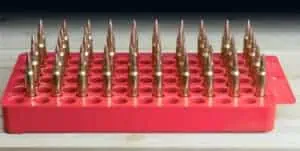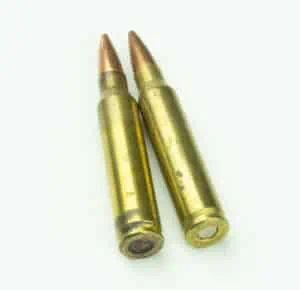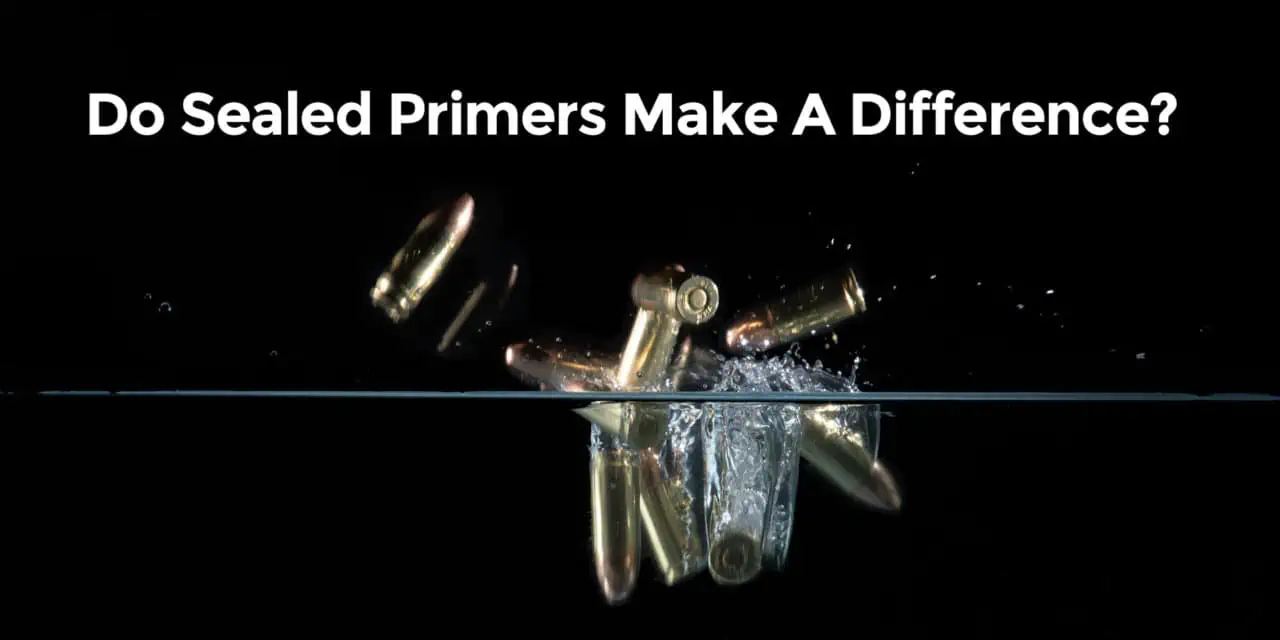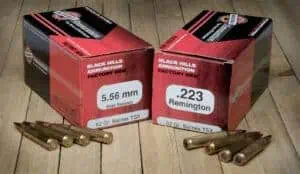What Is A Sealed Primer, And What Does It Do?
The modern metallic cartridge is the current pinnacle of ballistics reliability. The integration of primer, powder, and bullet into one compact, easy-to-carry package revolutionized gun design and continues to evolve to this day. While today’s ammo is sold as one complete unit, the separate components used to make each round can fail individually. This can cause a failure of the round to fire.
The primer at the bottom of each round is one of the key points of failure in ammunition. If any foreign matter (usually a liquid) seeps inside the cartridge via the primer pocket, the chances of the round failing to fire go up significantly. If the primer fails to ignite, then the gunpowder inside the cartridge will also fail to ignite, and you won’t get a “bang.”
To guard against this, many ammunition manufacturers coat the primer with a thin layer of lacquer or similar waterproofing material. This is supposed to protect the primer compound and gunpowder inside the cartridge. It helps ensure maximum reliability.
But is that sealant effective? Is it really needed? Water and moisture are definitely a threat out in the field. Oil and other petroleum products have an adverse effect on primer and powder alike. Is a sealed primer pocket an effective defense against these outside contaminants?
We sought to find out.
Testing Sealed Primers Versus Unsealed Primers
We developed a test to measure the effectiveness of sealing the primer pocket.
We shot 400 rounds each of two different rifle loads from Black Hills Ammunition: the 62 grain 5.56mm, which has a sealed primer pocket, and the 62 grain .223, which is unsealed.
We immersed the rounds’ primer pockets in different contaminants for various amounts of time and then shot the rounds to test the results.
- 200 rounds of each load were immersed in water.
- 100 rounds were immersed in lightweight motor oil.
- The remaining 100 rounds were left alone as a control.
We used reloading trays to ensure we were only immersing the primers in the fluid. We didn’t want moisture/oil/water to sneak in where the bullet and casing meet. We’re testing primer sealant, after all.
After 24 hours, we wiped off, dried, and shot 50 rounds of each caliber that had been immersed in water, 50 rounds of each caliber that had been immersed in oil, and 50 control rounds.
We saved the remaining rounds to fire 30 days later.
The remaining rounds we covered in oil were wiped off and dried after 24 hours, then shot 30 days later. 50 rounds of each caliber were allowed to remain with their primers immersed in water for 30 days and then shot. Finally, 50 rounds of each caliber spent 24 hours with their primers immersed in water and were then removed from the water and sealed in an airtight container for 30 days. This was designed to mimic the effects of storing ammo in a very damp and humid environment.
All ammunition was shot from an 11.5 inch AR-pattern pistol fitted with a Primary Weapons Systems AR-15 upper and a Sig Sauer suppressor. We tested the speed of both the 5.56mm and .223 rounds with a chronograph during each phase of the testing.
To recap, the first phase of testing procedure was:

To guard against any leakage from the cartridge neck or else where, we’ll use reloading trays to soak just the primers in each liquid.
Black Hills 62 Grain .223, Non-Sealed (50 Rounds Each)
Primers immersed in water for 24 hours, then shot
Primers immersed in motor oil for 24 hours, then shot
Control group
Black Hills 62 Grain 5.56mm, Sealed (50 Rounds Each)
Primers immersed in water for 24 hours, then shot
Primers immersed in motor oil for 24 hours, then shot
Control group
The second phase of the testing procedure was:
Black Hills 62 Grain .223, Non-Sealed (50 Rounds Each)
Primers immersed in water for 24 hours, then shot 30 days later
Primers immersed in water for 30 days, then shot
Primers immersed in motor oil for 24 hours, then shot 30 days later
Primers immersed in water for 24 hours, sealed in an airtight container for 30 days, then shot
Black Hills 62 Grain 5.56mm, Sealed (50 Rounds Each)
Primers immersed in water for 24 hours, then shot 30 days later
Primers immersed in water for 30 days, then shot
Primers immersed in motor oil for 24 hours, then shot 30 days later
Primers immersed in water for 24 hours, sealed in an airtight container for 30 days, then shot
Results: Test Phase One
Black Hills 62 Grain .223, Non-Sealed
Primers immersed in water for 24 hours, then shot: No anomalies. Average speed of 2637 fps
Primers covered in motor oil for 24 hours, then shot: No anomalies. Average speed of 2632 fps
Control group: No anomalies. Average speed of 2623 fps
Black Hills 62 Grain 5.56mm, Sealed
Primers immersed in water for 24 hours, then shot: No anomalies. Average speed of 2832 fps
Primers covered in motor oil for 24 hours, then shot: No anomalies. Average speed of 2876 fps
Control group: No anomalies. Average speed of 2883 fps
As you can see, performance was not negatively impacted after only 24 hours. To be honest, I’m not surprised by these results, as 24 hours isn’t very long for something to take hold inside the ammunition’s primer pocket.
Let’s move on to phase two to see if more time yields a different result.
Results: Test Phase Two
Before we reveal the results of phase two, let’s pause for a moment to talk about what I was expecting to see here. I know from personal experience that when oil contaminates a cartridge’s primer, the primer is rendered pretty useless. Squib rounds are very common with contaminated primers, as are misfires and duds.
Based on my experience, I was expecting to see some material impact on performance in the non-sealed .223 rounds after 30 days of contamination. I was also expecting the sealed primer pockets on the 5.56mm rounds to provide more protection from the effects of the oil and water left on the primer.
That said, here are the results:

The ammunition kept in a damp, watertight environment showed tarnishing on the brass and some smearing on the primer sealant. However, this did not affect reliability.
Black Hills 62 Grain .223 Non-Sealed
Primers immersed in water for 30 days, then shot: No anomalies. Average speed of 2606 fps
Primers immersed in motor oil for 30 days, then shot: No anomalies. Average speed of 2610 fps
Primers immersed in water for 24 hours, sealed in an airtight container for 30 days, then shot: No anomalies. Average speed of 2585 fps
As a reminder, the control group for the .223 yielded no anomalies and an average speed of 2623 fps.
Black Hills 62 Grain 5.56mm Sealed
Primers immersed in water for 30 days, then shot: No anomalies. Average speed of 2779 fps
Primers covered in motor oil 30 for days, then shot: No anomalies. Average speed of 22814 fps
Primers immersed in water for 24 hours, sealed in an airtight container for 30 days, then shot: No anomalies. Average speed of 2822 fps
The control group for the 5.56mm yielded no anomolies and an average speed of 2883 fps.
Wrapping Up The Sealed vs. Unsealed Primers Test
Based on these results, it appears that cartridges with unsealed primers are as resistant as those with sealed primers to damage caused by water, oil, and humidity for periods up to 30 days. In addition, judging by the similarities in the chronograph results for each test, there does not appear to have been any powder contamination in any of the rounds we tested. Each round’s speed was comparable to that from the control group, indicating that the powder burned consistently, no matter what liquid it was soaking in.
That does not mean there is no value in sealing your primers to protect your ammunition over longer periods. Our test only lasted 30 days. It is possible that a longer test could yield different results. It is also quite common for competitive shooters who reload their own ammunition to seal their primers to ensure maximum reliability. One dud round can make the difference between first and second place at a match. Sealing the primers on your match ammo gives you one less thing to worry about.
Are Sealed Primers Effective?
Based on our test, we do not find that sealed primers improve reliability over unsealed primers over the short run. If your ammo is recently manufactured from a reputable manufacturer, then shoot it with confidence, regardless of whether it has a sealed primer.




This test is not realistic for sealed US mil spec ammunition. US mil spec ammo is designed to be cached long term in the worst environments on the planet. Also, your lots are far to small for any meaningful test. As well, your test does not take into account the vast environmental differences between locales.
A better test would have been at least four lots of hundreds or thousands of rounds each; two lots of sealed and two of unsealed. Then add bleach, gas, oil, water and dirt to one sealed lot and one unsealed lot. Bury all of it, then dig it up on a periodic schedule and test fire it. Rinse and repeat….
I used Winchester 9mm bought at Walmart, I put it in my carry pistol, after months I tried it and none went off. Put them in a Glock and still no bang. Now the weapon was in a leather holster in my pocket. Subject to sweat and humidity.
I then used fingernail polish to coat the primer and crimp. After months of carry I rested them and they all fired. I believe that the primer was the problem and that the nail polish sealed it.